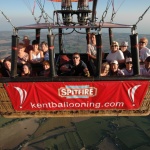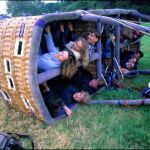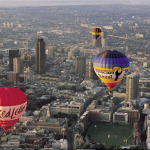 There is a future for commercial balloon pilots, especially those that hold a UK CPL. It is widely accepted that holders of it have been trained to the highest standard and indeed many overseas operations model their operations on the UK system. The other point is that, like it or not, many commercial pilots are now getting on in years and hanker for a change. Get the licence and the experience and you could end up flying anywhere from Canada, Burma, Australia and Africa, even Kent!
There is a future for commercial balloon pilots, especially those that hold a UK CPL. It is widely accepted that holders of it have been trained to the highest standard and indeed many overseas operations model their operations on the UK system. The other point is that, like it or not, many commercial pilots are now getting on in years and hanker for a change. Get the licence and the experience and you could end up flying anywhere from Canada, Burma, Australia and Africa, even Kent!
With the temporary retreat of EASA in connection with the bonkers EASA licencing system it seems even more important to keep abreast of the rules and regulations that apply to the UK system whilst it is still in place. Now, it has long been a complaint that no one really understands or supplies information on the UK Commercial Pilot Licence (UK CPL), the Training, Flight Test and quite how it all works after you get one, especially if you want to get a job flying passengers. This is what this is all about. With the buffoon that is EASA it is doubly important now that if you ever intend to carry out commercial work at any level you seriously think about getting a UK CPL as soon as you can and certainly before they regroup and come back in another full scale lunge. Whatever happens the CAA have hinted on more than one occasion that they will still support the UK CPL, one way or another even if Captain Europe won’t accept it.
There were suggestions that the CAA would stop holding UK CPL(B) (the ‘B’ stands for ‘balloons’) exams, even after EASA stepped back but, mainly as a result of a tremendous amount of hard work by Ian Chadwick of the CAA and Kevin Meehan (the Chairman of the Panel of Examiners), it is now back in safe hands for a few more years yet and exams will be held at Gatwick for at least another year. Before we go any further all types of Examiners, including Type Rating Examiners (TREs), are appointed by the CAA to whom they pay a large amount of money for the privilege every three years. They meet annually as ‘The panel of Examiners’ to discuss matters examining and approve instructors amongst other things.
We frequently get calls concerning how to get going when it comes to passenger flying and as a result Kevin Meehan has put together a pretty straightforward guide on the requirements as they are understood and approved by all parties. So, if you now have a nice smart freshly laundered CPL and want to go passenger carrying and get a job in Burma you will need a Base and Line Check. When you took your CPL Check Flight you would have been issued a CPL along with a type rating relevant to the size of balloon you took your test in. Interestingly, or bonkersly, if you took it in a 120 or over then you will get a Group B type rating and if you want to charge a fortune for exclusive flights in a 105 you will need to get a Group A rating first. This process is called ‘adding an additional rating’. Now before you can thunder skywards with a basket load of punters you are going to have to do a Base and line Check in the Group you intend to use. Providing you have a lower type rating then a Base and Line Check in a higher rating will cover you. Most pilots elect to do their CPL check flight in a Group A (up to ‘120) and, as they gain experience, add ratings. Now fortunately any Type Rating Examiner  (TRE) can do this but TREs can only carry out a Base & Line check in the type ratings in which they are approved. Bottom line is that you need a type rating on the type you intend to have the Base and Line check in. You can’t combine the Type Rating and Base and Line check flight. So to have a Base and Line check in a Group C balloon if you have been flying Group B balloons you will need to add a Group C type rating to your licence. To be successful you will also have to have attended a CAA Approved Fire and First Aid Course which once passed will be valid for three years. Over to Kevin.
(TRE) can do this but TREs can only carry out a Base & Line check in the type ratings in which they are approved. Bottom line is that you need a type rating on the type you intend to have the Base and Line check in. You can’t combine the Type Rating and Base and Line check flight. So to have a Base and Line check in a Group C balloon if you have been flying Group B balloons you will need to add a Group C type rating to your licence. To be successful you will also have to have attended a CAA Approved Fire and First Aid Course which once passed will be valid for three years. Over to Kevin.
Base and Line Check flight
Pilots with a CPL (B), who have obtained a type rating, need to receive training for a Base and Line Check and then pass a test flight with a Type Rating Examiner before undertaking AOC operations as a company line pilot. This training is to ensure that pilots are operating to AOC standards / Operations Manual requirements and to prepare them for the Base and Line check. Normally the Company Training Pilot is responsible for supervising the training but this maybe delegated to other senior company pilots. If the pilot (under instruction) is not able to undertake this training as pilot-in-command under supervision (P1 u/s) within an AOC operation, this training should be conducted as if each flight was an AOC flight in every respect and should be with a senior CPL (B) holder who has extensive experience on the applicable balloon Group and be working for an established AOC operation. The length and content of programme should be based on the pilot under instruction’s previous flight experience and if they have previously worked for an AOC.
It is recommended that a minimum of five training flights are completed before the Training Pilot can assess the pilot’s progress. This training will need to include completion of tech logs (“dummy” tech logs on non AOC flights), knowledge of the Operations Manual and practice completion of FTL duty hours sheets. The Training Pilot will make the decision on the readiness of the pilot under instruction for the Base and Line Check flight test, but only when all the training exercises have been completed to a satisfactory standard.
 The following exercises should be practised and completed to a satisfactory standard by the pilot under instruction. All exercises should be signed by the training pilot and recorded in both pilots’ log books.
The following exercises should be practised and completed to a satisfactory standard by the pilot under instruction. All exercises should be signed by the training pilot and recorded in both pilots’ log books.
Preparation for flight: Satisfactory is when the pilot under instruction is able to complete all pre-flight requirements including full completion of the combined Technical Log, Sector Record Page, Load sheet and Passenger Manifest (tech logs), passenger briefing and handling, including the followers.
Inflation and take off: Satisfactory is when the pilot able to inflate and take off in wind speeds up to 8 knots (the Company Operations Manual has specific limitations on wind speeds for inexperienced pilots).
In flight: Satisfactory is when the pilot is able to complete all in flight requirements – fuel management, navigation, passenger handling, etc.
Landings: Satisfactory is when the pilot is able to land safely in wind speeds up to 8kts. (The Company Operations Manual has specific restrictions on wind speeds for inexperienced pilots)
Post Flight Actions: Satisfactory is when the pilot is able to complete all post flight requirements including full documentation completion, e.g. Sign (only as approved) and complete tech log, carrying forward relevant information to the following sequentially numbered sheet ( note Captain must sign the “Nil Defects” on the tech log, but the P1/s may sign all other boxes upon undertaking the required activity.) ;complete aircraft logbook; complete personal flying logbook – to be signed by the Training Captain.
Emergencies: Satisfactory is when the pilot is able to demonstrate and/or show knowledge of the required procedures.
That covers the training requirements as they currently stand for a UK CPL(B) as far as our illustrious Chairman is concerned. It isn’t onerous and by allowing training as a pilot under supervision it is achievable. It is important to bear in mind that it is expected that the pilot should have an understanding and knowledge of the AOC Holders’ Operation Manual and that they may well be questioned on aspects of it. To all intents  and purposes a pilot is tested as if they are flying passengers for an operational company. Once the Training Pilot is happy that the candidate has met the standards only then should they go forward and book the Type Rating Examiner. A successful Base and Line Check is valid for a thirteen month period. The training standards for the UK CPL and the re-validation process is very high so it doesn’t often happen but pilots have failed the Base & Line Check, even experienced ones when renewing. Next up we’ll look at the test itself.
and purposes a pilot is tested as if they are flying passengers for an operational company. Once the Training Pilot is happy that the candidate has met the standards only then should they go forward and book the Type Rating Examiner. A successful Base and Line Check is valid for a thirteen month period. The training standards for the UK CPL and the re-validation process is very high so it doesn’t often happen but pilots have failed the Base & Line Check, even experienced ones when renewing. Next up we’ll look at the test itself.
Piccies courtesy of Balloons over Britain, Adventure Balloons, Kent Balloons, Ken Spence (Balloons over Bagan).